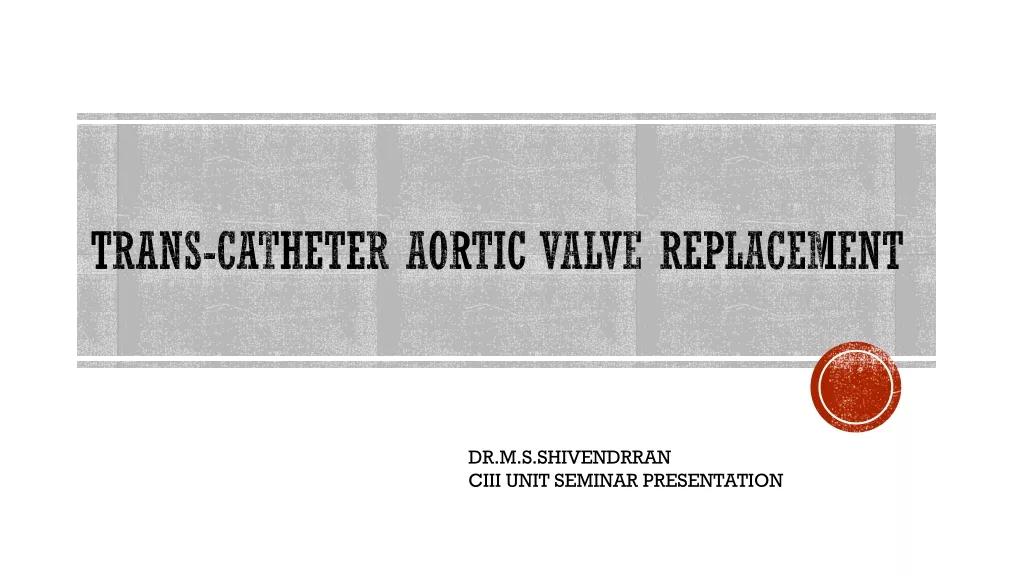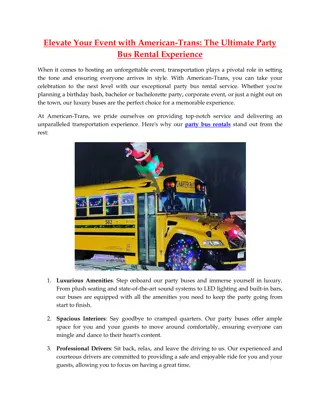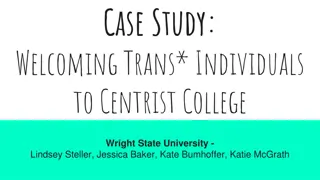
Implementing Virtual Memory Manager Using Segmentation and Paging
Design and implement a virtual memory system that utilizes segmentation and paging techniques to manage segment and page tables in simulated main memory. The system translates virtual addresses into physical addresses and optimizes the process with a translation look-aside buffer (TLB).
Download Presentation

Please find below an Image/Link to download the presentation.
The content on the website is provided AS IS for your information and personal use only. It may not be sold, licensed, or shared on other websites without obtaining consent from the author. If you encounter any issues during the download, it is possible that the publisher has removed the file from their server.
You are allowed to download the files provided on this website for personal or commercial use, subject to the condition that they are used lawfully. All files are the property of their respective owners.
The content on the website is provided AS IS for your information and personal use only. It may not be sold, licensed, or shared on other websites without obtaining consent from the author.
E N D
Presentation Transcript
Project: Virtual Memory Manager Lubomir Bic 1
Assignment Design and implement a virtual memory system (VM) using segmentation and paging The system manages the necessary segment and page tables in a simulated main memory It accepts VA s and translates them into PA s It also utilizes a translation look-aside buffer (TLB) to make the translation process more efficient 2
Organization of the VM system There is only a single process and hence a single ST Each ST entry points to a PT Each PT entry points to a program/data page A VA is an integer (32 bits), divided into s, p, w. |s|=9, i.e., ST size is 512 words (int) |p|=10, i.e., PT size is 1024 words |w|=9, i.e., page size is 512 words The leading 4 bits of the VA are unused. 4
Organization of the VM system Each ST entry can have three types of entry: -1: PT is currently not resident in PM (page fault) 0: corresponding PT does not exist read: error; write: create blank PT f: PT starts at physical address f (address, not frame #) Each PT entry can also have three types of entry: -1: page is currently not resident in PM (page fault) 0: corresponding page does not exist read: error; write: create blank page f: page starts at physical address f 5
Organization of PM PM is represented as an array of integers each corresponds to one addressable memory word PM is divided into frames of size 512 words (integers) consequently, ST occupies one frame each PT occupies two (consecutive) frames each program/data page occupies one frame PA consists of 1024 frames (=array of 524,288 int, =2MB) Consequently the size of PA is 19 bit ST always resides in frame 0 and is never paged out A page may be placed into any free frame A PT may be placed into any pair of consecutive free frames 6
Organization of PM PM[s] PM[PM[s]+p] s p w ST page PT PM[s] accesses the ST If the entry is >0 then it points to a resident PT PM[PM[s]+p] accesses the PT If the entry is >0 then it points to a resident page All ST/PT entries are multiples of 512 (fame size) Operating Systems 7
Organization of PM A bit map is used to keep track of free/occupied frames The bit map consists of 1024 bits (one per frame) It can be implemented as an array of 32 integers Normally this would be maintained inside the PM but in this project it may be implemented as a separate data structure 8
Address Translation Process Break each VA into s, p, w For read access: If ST or PT entry is -1 then output pf (page fault) and continue with next VA If ST or PT entry is 0 then output err and continue with next VA Otherwise output PA = PM[PM[s] + p] + w PM[s] PM[PM[s]+p] s p w ST page PT Operating Systems 9
Address Translation Process For write access: If ST or PT entry is -1 then output pf If ST entry is 0 then allocate new blank PT (all zeroes) update the ST entry accordingly continue with the translation process; PM[s] PM[PM[s]+p] s p w ST page PT Operating Systems 10
Address Translation Process For write access (cont.): if PT entry is 0 then create a new blank page update the PT entry accordingly continue with the translation process Otherwise output the corresponding PA PM[s] PM[PM[s]+p] s p w ST page PT Operating Systems 11
Initialization of PM Read init file: s1 f1 s2 f2 sn fn p1 s1 f1 p2 s2 f2 pm sm fm si fi : PT of segment si startsat address fi If fi= 1 then the corresponding PT is not resident Example: 15 512: PT of seg 15 starts at address 512. 9 -1: PT of seg 9 is not resident pj sj fj : page pj of segment sj startsat address fj If fi= 1 then the corresponding page is not resident Example: 7 13 4096: page 7 of seg 13 starts at 4096 8 13 -1: page 8 of seg 13 is not resident Operating Systems 12
Initialization of PM Initialize PM as follows: Read si fi pairs and make corresponding entries in ST Read pj sj fj triples and make entries in the PT s Create bitmap to show which frames are free Note: each f is a PA, not just a frame number!! Operating Systems 13
Running the VM Translations Read input file: each oi is either a 0 (read) or 1 (write) each VAi is a positive integer (virtual address) o1 VA1 o2 VA2 on VAn For each oi VAi pair attempt to translate the VA to PA Write results into an output file Operating Systems 14
The TLB Size: 4 lines LRU: int 0:3 0: least recently accessed sp: int f: int (starting frame address, not frame #) Operating Systems 15
Running Translations with TLB Break VA into sp and w Search TLB for match on sp If TLB hit: use f from TLB to form PA = f+w update LRU fields as follows: assume the match is in line k, then: decrement all LRU values greater than LRU[k] by 1 set LRU[k] = 3 Operating Systems 16
Running Translations with TLB If TLB miss: resolve VA as before in case of error or page fault, no change to TLB if a valid PA is derived then TLB is updated as follows: select line with LRU = 0 and set this LRU = 3 replace sp field of that line with the new sp value replace f field of that line with PM[PM[s] + p] decrement all other LRU values by 1 Output PA, pf , or err as before For each PA also output h (if hit ) or m (if miss) Operating Systems 17
The Bit Map (pg 217) Creating a new page or PT requires searching and updating the BM BM size: # of bits needed = # of page frames represent bit map as an array of int (32 bits each): BM[n] How to set, reset, and search for bits in BM? prepare a mask array: MASK[32] diagonal contains 1 , all other fields are 0 use bit operations (bitwise or/and) to manipulate bits 18
The Bit Map MASK (assume 16 bits only to simplify presentation) 0 1 2 3 10 010 0010 00010 15 0 01 to set bit i of BM[j] to 1 : BM[j] = BM[j] | MASK[i] 19
The Bit Map how to create MASK? MASK[0] = 0x8000 (1000 0000 0000 0000) MASK[1] = 0x4000 (0100 0000 0000 0000) MASK[2] = 0x2000 (0010 0000 0000 0000) MASK[3] = 0x1000 (0001 0000 0000 0000) MASK[4] = 0x0800 (0000 1000 0000 0000) MASK[15] = 0x0001 (0000 0000 0000 0001) another approach: MASK[15] = 1; MASK[i] = MASK[i+1] << 20
The Bit Map to set a bit to 0 : create MASK2, where MASK2[i] = ~MASK[i] e.g., 0010 0000 0000 0000 1101 1111 1111 1111 set bit i of BM[j] to 0 : BM[j] = BM[j] & MASK2[i] 21
The Bit Map to search for a bit equal to 0 in BM: for (i=0; /* search BM from the beginning for (j=0; /* check each bit in BM[i] for 0 test = BM[i] & MASK[j]) if (test == 0) then bit j of BM[i] is 0 ; stop search 22
Summary of tasks Design and implement a VM memory system using segmentation and paging as described above. Design and implement a TLB to speed up the address translation process Design and implement a driver program that initializes the system from a given input file. It then reads another input file and, for each VA, attempts to translate it to the corresponding PA. It outputs the result of each address translation into a new file. Submit documentation Schedule testing 23






















